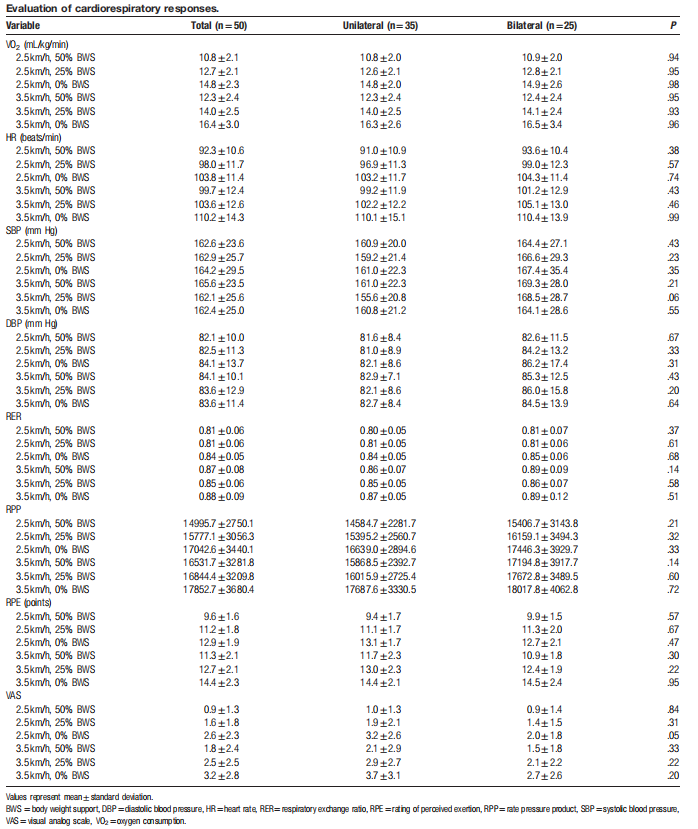Key words: arthroplasty, cardiopulmonary exercise test, knee, osteoarthritis, rehabilitation
Purpose:To investigate the effects of body weight support (BWS) and gait velocity on cardiovascular responses during walking on an antigravity treadmill early after unilateral and bilateral total knee arthroplasty (TKA).
Methods:This study was a cross-sectional study design. Fifty patients (7 males and 43 females; average age, 72.0±5.1 years) at 4 weeks after unilateral (n=25) and bilateral (n=25) primary TKA were enrolled in the study. Subjects walked on an antigravity treadmill at speeds of 2.5 km/hour and 3.5 km/hour with 3 levels (50%, 25%, and 0%) of BWS. Cardiovascular responses were monitored by measuring oxygen consumption (VO2), heart rate (HR), systolic and diastolic blood pressure (SBP/DBP), the respiratory exchange ratio (RER), and rate pressure product (RPP). Borg rating of perceived exertion (RPE) and a visual analog scale (VAS) of knee pain were recorded immediately after each trial.
Results:This study was a cross-sectional study design. Fifty patients (7 males and 43 females; average age, 72.0±5.1 years) at 4 weeks after unilateral (n=25) and bilateral (n=25) primary TKA were enrolled in the study. Subjects walked on an antigravity treadmill at speeds of 2.5 km/hour and 3.5 km/hour with 3 levels (50%, 25%, and 0%) of BWS. Cardiovascular responses were monitored by measuring oxygen consumption (VO2), heart rate (HR), systolic and diastolic blood pressure (SBP/DBP), the respiratory exchange ratio (RER), and rate pressure product (RPP). Borg rating of perceived exertion (RPE) and a visual analog scale (VAS) of knee pain were recorded immediately after each trial.
Article cited in:Kim et al. Medicine (2020) 99:14.
Knee osteoarthritis (OA) is the leading cause of disability in older adults, in whom pain and swelling in the affected joint is often accompanied by a progressive decline in functional activity. Patients with end-stage knee OA are typically overweight and have lower limb muscle strength and lower exercise tolerance than patients who do not have knee OA; this results in cardiovascular deconditioning. Mean peak oxygen consumption (VO2 peak) levels in those with end-stage knee OA typically range from 13.9±3.3 to 14.4± 3.2mL/kg/min. This is approximately 65% lower than those in age and sex-matched.

Cardiovascular deconditioning not only reduces patient mobility, thereby impairing activities of daily living and reducing quality of life, but also worsens underlying cardiovascular and metabolic risk factors such as hypertension, obesity, diabetes, and dyslipidemia. Thus, patients scheduled for total knee arthroplasty (TKA) tend to show a higher prevalence of coronary heart disease.Smith et alreported that myocardial infarction is the most common cause of death within 30 days after elective hip and knee arthroplasty.
After the experiment, we found that under different BWS conditions, the changes in vanadium dioxide, HR, RPP, RPE, RER and VAS were significantly different (50%, 25%, 0%), while under the same BWS conditions, When the vanadium dioxide, RPE and RER values are all greater than 2.5km/h.
During antigravity treadmill walking, pressure applied around the lower extremities may increase venous return and mean arterial pressure, followed by a reflex decrease in heart rate due to baroreceptor stimulation of the arterial system; this would reduce the demand on the heart as a central mechanism.
The reduction in metabolic demand on the heart when walking on an antigravity treadmill may be attributed more to peripheral mechanisms than to central mechanisms. The lower heart rate seen with increased BWS levels may also place less demand on the heart due to the lighter load during antigravity treadmilling. Furthermore, these findings may benefit not only older adults with TKA, but also older adults with various musculoskeletal disorders, as most older adults typically have higher resting blood pressure and lower blood pressure than younger adults. Baroreceptor reactivity is also reduced.
The experimental data is as follows:

Here, we demonstrate that cardiovascular responses are affected by a combination of BWS and gait velocity during training on an antigravity treadmill. Also, the level of knee pain experienced during exercise was influenced more by the level of BWS than by gait velocity. Therefore, when attempting to improve aerobic conditioning of patients after TKA (using an antigravity treadmill and/or walking aids), BWS and gait velocity should be considered carefully and set appropriately.